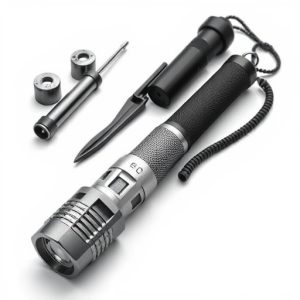Master Self-Defense with Expandable Baton: Stance, Footwork, and Tactics
The self-defense expandable baton is a lightweight yet sturdy tool designed for personal safety, off…….
The self-defense expandable baton is a lightweight yet sturdy tool designed for personal safety, offering discreet protection in close quarters. Mastering its use begins with a balanced defensive stance and advanced footwork techniques. By combining these skills with the baton's strategic deployment, users can enhance their protection capabilities, deterring threats and providing valuable time to escape or seek help.
Unleash your inner defender with a comprehensive guide on mastering the art of self-defense using an expandable baton. This powerful tool offers enhanced protection in various situations. From understanding the baton’s capabilities to refining your defensive stance and footwork, this article is your roadmap to effective self-defense. Learn techniques that empower you to maintain balance, execute precise side steps, and combine these with baton use for maximum impact. Get ready to navigate potential threats with confidence.
- Understanding the Self-Defense Expandable Baton: Tools and Benefits
- Mastering the Basic Baton Defensive Stance: Posture and Balance
- Footwork Techniques for Effective Baton Defense: Side Steps and Maneuvers
- Advanced Tactics: Combining Stance, Footwork, and Baton Use for Maximum Protection
Understanding the Self-Defense Expandable Baton: Tools and Benefits
The self-defense expandable baton, also known as a tactical baton or collapse stick, is a versatile tool designed for personal safety and security. This multi-purpose device offers a range of benefits when it comes to defending oneself in various situations. Its primary function is to provide an additional layer of protection, allowing users to deter potential threats effectively.
With its lightweight yet sturdy construction, the self-defense expandable baton can be easily concealed, ensuring discreet self-defense capabilities. The ability to extend and collapse the baton makes it a handy tool for close-quarters combat and escape maneuvers. Its rugged design enables users to apply pressure points and control an attacker, providing valuable time to escape or call for help. This weapon is not only a powerful deterrent but also offers enhanced mobility compared to larger self-defense weapons.
Mastering the Basic Baton Defensive Stance: Posture and Balance
Mastering the fundamental defensive stance with a self-defense expandable baton is crucial for effective use in real-world scenarios. The key lies in achieving optimal posture and balance—a sturdy foundation that allows for swift, precise movements. Stand tall, keeping your back straight and shoulders relaxed, while aligning your feet shoulder-width apart for stability. Distribute your weight evenly, ensuring a firm plant of the feet to enable quick shifts and turns during defense maneuvers.
Engage your core muscles, drawing them in slightly to stabilize your torso and maintain control throughout defensive actions. Practice maintaining this balanced stance through isometric exercises, reinforcing muscle memory essential for reacting swiftly under pressure. With proper posture and balance established, you’re ready to explore advanced techniques, enhancing your ability to defend yourself confidently with the self-defense expandable baton.
Footwork Techniques for Effective Baton Defense: Side Steps and Maneuvers
In the art of self defense with an expandable baton, footwork is a crucial component for effective and efficient protection. The side step is one of the fundamental techniques to master. It involves a quick shift of weight from one side to the other, allowing you to maintain balance while keeping your body out of direct range of an attacker’s strikes. This maneuver enables you to sidestep kicks, punches, or charges, giving you precious time to assess and respond. By combining the side step with proper baton extension and retention, you can create distance between yourself and the threat, making it easier to defend against various attacks.
Additionally, mastering different footwork maneuvers like pivoting, crossing, and backpedaling further enhances your defensive capabilities. Pivoting allows for a quick change of direction, enabling you to turn away from an incoming attack while keeping your baton extended. Crossing your feet can help you maintain stability during a sudden dodge or sidestep. Backpedaling is essential when facing multiple attackers, as it lets you retreat and gain better positioning while still brandishing the baton defensively. These techniques, when executed smoothly and efficiently, demonstrate the versatility of an expandable baton as a self-defense tool, empowering users to navigate dangerous situations with agility and confidence.
Advanced Tactics: Combining Stance, Footwork, and Baton Use for Maximum Protection
In advanced self defense scenarios, mastering the art of combining your defensive stance, footwork, and the strategic use of a self-defense expandable baton can significantly enhance your protection capabilities. This intricate dance involves precise movements and thoughtful timing to ensure maximum effectiveness. By integrating these elements seamlessly, you create an impenetrable barrier against potential threats.
The key lies in synchronizing your stance—with feet firmly planted for stability—and footwork that allows for quick shifts and directional changes. Simultaneously, the baton acts as both a deterrent and a powerful tool, extending your reach and adding force to your defensive actions. This combination requires practice and mindfulness, but it offers a game-changing advantage in high-pressure situations, allowing you to defend yourself with confidence and precision using just a self-defense expandable baton.
The self-defense expandable baton is a versatile tool that empowers individuals to protect themselves effectively. By understanding the proper defensive stance, mastering basic footwork techniques, and combining these with advanced tactics, users can maximize their protection potential. This comprehensive guide equips folks with the knowledge and skills needed to navigate dangerous situations confidently, ensuring they have a powerful defense at their disposal in today’s world.


